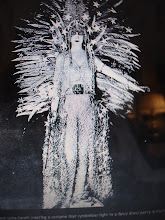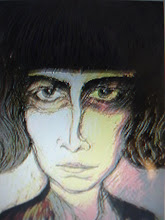Today, the 3rd of November (already?) I walked through the beautiful golden light filtering through the turning leaves of the ginko trees lining Beekman Place to
Financier, the new patisserie down the street from my apartment. Since it opened a month or so ago, I have begun to think of it as my second home. I often meet friends there for tea or a light lunch. Today I carried a book by one of my favorite poets, Sir John Betjeman, former Poet Laureate of England--and a sly old fox he is. I wanted to check out of 2009 for an hour or so and return to an England lost to us forever. An England which Betjeman captures with wicked humor, joy and even humility. Really, if you ever just want to curl up for some magical hours, give yourself the pleasure of reading this fine poet.
Here's one of my favorites:
How To Get On In SocietyPhone for the fish knives, Norman
As cook is a little unnerved;
You kiddies have crumpled the serviettes
And I must have things daintily served.
Are the requisites all in the toilet?
The frills round the cutlets can wait
Till the girl has replenished the cruets
And switched on the logs in the grate.
It's ever so close in the lounge dear,
But the vestibule's comfy for tea
And Howard is riding on horseback
So do come and take some with me
Now here is a fork for your pastries
And do use the couch for your feet;
I know that I wanted to ask you-
Is trifle sufficient for sweet?
Milk and then just as it comes dear?
I'm afraid the preserve's full of stones;
Beg pardon, I'm soiling the doileys
With afternoon tea-cakes and scones.
You may want to read a short biography--well worth your time.
ir John Betjeman (1906-1984), Poet Laureate of Britain from 1972 to 1984, was the most popular English poet of the 20th century and a familiar personality on British television.John Betjeman was born in London on August 28, 1906, the only child of a prosperous silverware maker of Dutch descent. A sensitive, lonely child, he knew early that he would grow up to forswear the family business in favor of poetry. He attended prep school at Highgate, London, where one of his instructors was a recent American arrival, T. S. Eliot, who proved unresponsive to the 10-year-old's poetic efforts. During his tenure at Dragon School, Oxford (1917-1920), Betjeman developed an abiding interest in architecture; he next attended Marlborough public school in Wiltshire, which he was to remember chiefly for its bullies.
He entered Magdalen College, Oxford, in 1925 and favorably impressed the great classics scholar C. M. Bowra with his knowledge of architecture, but negatively impressed his famous tutor C. S. Lewis by his academic indifference. At Oxford he struck up a lasting friendship with Evelyn Waugh and may even have served as a model for one or more of the characters in Waugh's early novels; more importantly, Betjeman cultivated at Oxford a strong aversion to sports and an equally strong inclination towards esthetics. He left Oxford in 1928 without a degree.
Early Career
Betjeman taught briefly at Heddon Court School, Hertfordshire, and then worked for a while as an insurance broker before becoming, in 1931, an assistant editor of the Architectural Review. That same year he published his first book of verse, Mount Zion. Although somewhat mannered and certainly minor, the collection was distinguished by at least one poem, "The Varsity Students' Rag," which quietly but effectively satirizes the mindless, boys-will-be-boys destructiveness of his former fellow Oxfordians.
In 1933 Betjeman became editor of the Shell series of topographical guides to Britain and married Penelope Chetwode, a writer by whom he had a son and a daughter, but who pursued her own writing career abroad for most of their married life. In 1934 he became film critic for the Evening Standard but was fired less than a year later for his overly enthusiastic reviews. Betjeman's second volume of verse, Continental Dew: A Little Book of Bourgeois Verse (1937), is undistinguished but for its foreshadowing of an attitude that was to fully surface in subsequent books: a deep-dyed distrust of "modernity" in all of its guises - its indifference to tradition, its runaway materialism, and its savaging of the landscape.
Betjeman's book titles and sub-titles are frequently thematic, as in his first book on architecture, Ghastly Good Taste: a depressing story of the rise and fall of English architecture (1933); it was followed by University Chest (1938) and then Antiquarian Prejudice (1939), which defines architecture for Betjeman as not mere building styles but as the total physical environment in which life is lived. His topographical writings, which celebrate actual places he loved and excoriate places he loathed, include Vintage London (1942), English Cities and Small Towns (1943), and First and Last Loves (1952).
Major Career
During World War II Betjeman served variously as United Kingdom press attaché to Dublin, as BBC broadcaster, and in the British Council books department. In this period he issued two volumes of verse that revealed him to be a serious poet and not a mere "versifier": Old Lights for New Chancels (1940) and New Bats in Old Belfries (1945). Although they share with most modern poetry a profound pessimism about life, these works established Betjeman as a distinctive voice and somewhat of an anomaly: in an age dominated by lyric-contemplative verse, Betjeman relied strongly on narrative, or at least anecdotal, elements; in an age of free verse, he wrote in tight metrical and stanzaic forms; in an age of poetic obfuscation, Betjeman, though not without his ambiguities, was accessible; in an age of tight Classical control of emotion, he was wistfully playful and even sentimental. In short, Betjeman was a throwback to the best-loved poets of English verse tradition - to Tennyson, Hardy, and Kipling.
In both volumes Betjeman made humanly evocative use of place (many of his poem titles are place names), reflecting the importance of topography in his work and projecting his thesis that as the landscape grows uglier the possibility of human happiness recedes. Both volumes sold well and were favorably reviewed, but Betjeman's reputation as an architecture and topography writer still outstripped his reputation as poet.
In the 1950s Betjeman continued to write prolifically on architecture and topography, produced a book of verse - A Few Late Chrysanthemums (1954), and did a year of BBC broadcasts (1957). Most important, he published his Collected Poems (1958), which was a huge seller, an astounding fact considering normal public indifference toward poetry and the consequent well-known indigence of almost all poets.
His popularity was enhanced by a blank-verse autobiographical poem, Summoned by Bells (1960), a quiet, introspective account of his first 22 years, and by two more verse collections, High and Low (1966) and A Nip in the Air (1975). Sandwiched between, in 1969 Betjeman was knighted and in 1972 he was appointed Poet Laureate of Britain.
Reputation and Last Years
His public acclaim notwithstanding, Betjeman had his detractors among poets, critics, and scholars, many of whom found him shallow or facile and branded him a Tory traditionalist or an English provincial or a hopeless antiquarian. His defenders and admirers, however, included Edmund Wilson, W. H. Auden (who dedicated The Age of Anxiety to Betjeman), and Philip Larkin.
A London journalist once described Betjeman as "looking like a highly intelligent muffin; a plump, rumpled man with luminous, soft eyes, a chubby face topped with wisps of white hair and imparting a distinct air of absentmindedness … [with] an eager manner, a kind of old-fashioned courtesy and a sudden, schoolboy laugh which crumples his face like a paper bag."
Poor health curtailed Betjeman's writing efforts in his later years, but what energies he had were dedicated to his continuing campaign for the preservation of historic buildings. After suffering from Parkinson's disease of a number of years, Betjeman had a stroke in 1981 and a heart attack in 1983. He died on May 19, 1984, at his home in Trebetherick, Cornwall, attended by his companion of many years, Lady Elizabeth Cavendish.
Courtesy of Biography Online


















